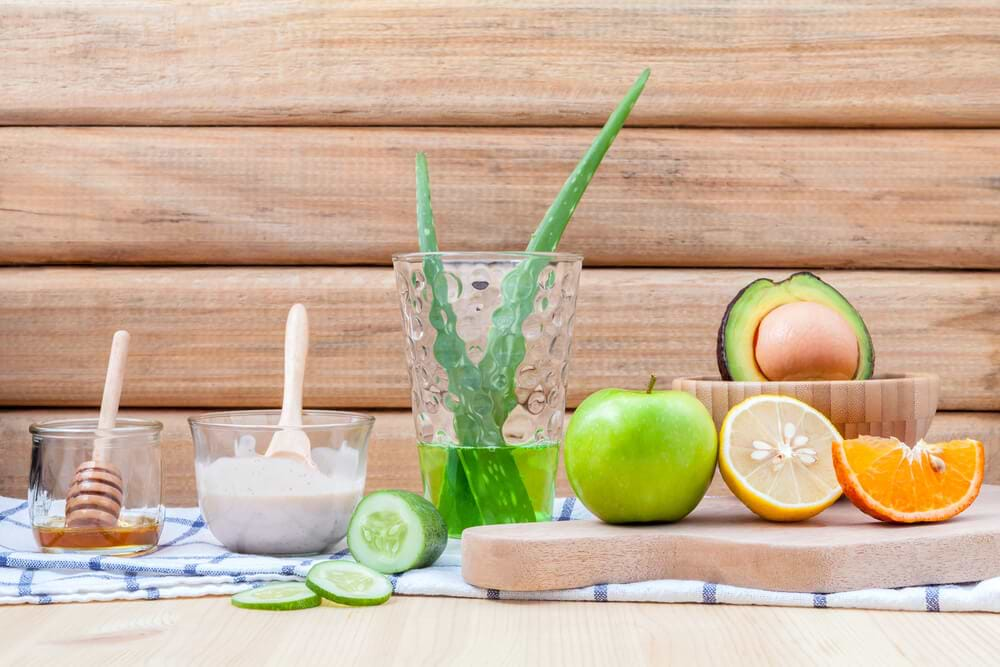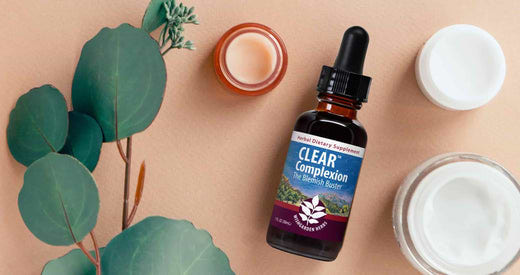What do you see when you see yourself? Or another? Our perceptions of "self" and "other" tend to come from the myriad ways in which we view our largest organ — our home — the skin. The concept of who we are and where we end and the rest of the world begins is defined by our skin. How our skin appears to us when we look in the mirror displays a lot of our story, including societal conditioning, the environments we've been in, and what we have or have not used as fuel and nutrition.
Rather than heeding the siren call of the billion-dollar skincare industry selling you the lie that your skin needs chemicals and costly procedures to appear radiant and attractive, show some loving kindness and awe to your most splendid organ! Your skin radiates your inner self to the world. Your light glows — particularly when you're joyful, grateful, in love, and excited. Your skin also gives clues to imbalances — disturbances within the self — whether from engaging in a battle in the mind, heart, or physical body. When that happens, the glow dims, our pigmentation begins to darken beneath our eyes, and swellings may rise like waves across our body in outbursts, pleading for our attention to turn inward.
Thankfully, help is never further away than our mother, the Earth. No matter where you find yourself, what skin houses you, and what your perception of self may be, place your feet on the ground to find what you need. The kaleidoscope of humanity's diversity is reflected in the flora of our planet. Look to your friends in the plant kingdom — they are waiting to deeply nourish all parts of you, allowing your truly radiant self to shine through the magical organ we refer to as our skin.
Traditional Herbs for Luminous Skin
Do you ever stop to wonder how your skin is able to perform the miraculous task of keeping you intact daily and over time, without you giving it a thought? Your skin's innate capacity to shield you from harm using its acid mantle, absorb life-giving sunlight, stretch and hold you as you grow into adulthood, and replenish itself continually is phenomenal! And for those who journey into motherhood, the skin's capacity to transform your body in the miracle of procreation … it's astounding!
Why then do we look in the mirror and believe the lies we are sold about our skin? The human body is meant to be nourished from the inside out and cherished for the uniqueness that is inherent in everyone. Let us celebrate our phenomenal skins, with all their unique pigmentations and features. For what they hold is sacred: our irreplaceable and divine spark of life.
As I've spoken to before, self-care is a lifestyle. We can enhance the skin's health and luminosity by allowing our plant allies to assist our integumentary system with hydration, cell turnover, and detoxification.
With our Clear Complexion: The Blemish Buster daily tonic and spot remedy, WishGarden Herbs has gathered a few of our favorite skin-loving plants to aid us.

We have learned from the wisdom of herbalists from an older time, like Nicolas Culpeper, who wrote of the virtues of Burdock root in The Complete Herbal, "the roots … help the … breaking out of the skin … and cleanse the skin … is exceedingly strengthening to the liver, and procures good blood … helps the running of the reins and bladder."¹
Many an herbalist knows that when calling in Burdock root, things can appear to get worse before they get better. Meaning, more eruptions of the skin may occur as the herb assists in clearing out all the excesses and restoring deeper organ function. You've gotta see it to believe it, right? That is why we trust in Burdock to assist in clearing out detoxification pathways, especially the skin.
Another traditional ally in this formula is Yellow Dock root. Medical herbalist David Hoffman considers Yellow Dock being used "extensively in the treatment of chronic skin complaints…Yellow Dock promotes the flow of bile…its influence on the gallbladder gives it a role in relieving skin congestion."² And he's not alone. Yellow Dock root is included in the British Herbal Pharmacopoeia as "indicated for the treatment of many skin issues."³
With both of these deeply restorative roots lending their hand in clearing out toxins and assisting our pathways of elimination, we further their support by synergizing with both Dandelion and Echinacea Purpurea roots. All together, they are a formidable team of movers, helping the self in identifying intruders and ushering out guests who have overstayed their welcome inside our bodies.
Our final two teammates in this dynamic formula, Calendula and red clover, probably need no introduction. Herbalists and the skincare industry alike rely heavily on their merits for promoting skin hydration, supporting free-radical elimination, supporting healthy inflammatory response, and supporting collagen.⁴ The art of modern herbal formulation involves blending ancient traditions with the best science of our age. A wonderful example of how science is catching up with the ancient wisdom of the plant stewards is research on Red Clover's potential to support the inflammatory response and oxidative stress, as observed in a recent study published last year in Nutrients, a peer-reviewed journal of human nutrition.⁵

Finally, it is worth noting that as you partner with herbal remedies, remember to resolve puffy eyes with plenty of sleep and dietary nourishment. Heal the heart with loving kindness. Soothe bruises and any physiological harm within the muscular-skeletal makeup of your body with rest, replenishment, and strengthening movement. Mend the fissures of the mind with meditation and reconciliation. And, as ever, get outside. Mother Nature is waiting with arms open wide for you.
References
- Culpeper N., M.D., The Complete Herbal, 1847, London, Thomas Kelly, pp. 64, 219, 258.
- Hoffman D., Medical Herbalism, The Science and Practice of Herbal Medicine, 2003, Vermont, Healing Arts Press, pp. 578-579.
- Evans W.C., Trasee and Evans' Pharmaccognosy, 16th Edition, 2009, St. Louis, Elsevier, p.25
- Circosta C., De Pasquale R., Palumbo D.R., Samperi S., Occhiuto F., Effects of isoflavones from Red Clover (Trifolium pretense) on skin changes induced by ovariectomy rats, Phytotherapy Research, 2006; 20 (12): 1096-1099.
- Lee, S.G.; Brownmiller, C.R.; Lee, S.-O.; Kang, H.W. Anti-Inflammatory and Antioxidant Effects of Anthocyanins of Trifolium pratense (Red Clover) in Lipopolysaccharide-Stimulated RAW-267.4 Macrophages. Nutrients 2020, 12, 1089.
Dawn Amber Miller has apprenticed and studied across the United States of America and has received certificates in traditional and medical herbalism from the Appalachia School of Holistic Herbalism, the Commonwealth Center for Holistic Herbalism, and the Hawthorn Institute. She is a passionate steward of the sacred realm of Nature and moves with the wildflowers, tending the rituals of wildcrafting heart and hand. Currently she is a customer journey representative and researcher at WishGarden Herbs.
For educational purposes only. This information has not been evaluated by the Food and Drug Administration. This information is not intended to diagnose, treat, cure, or prevent any disease, or sell any product.
Recommended Products
Further Reading









